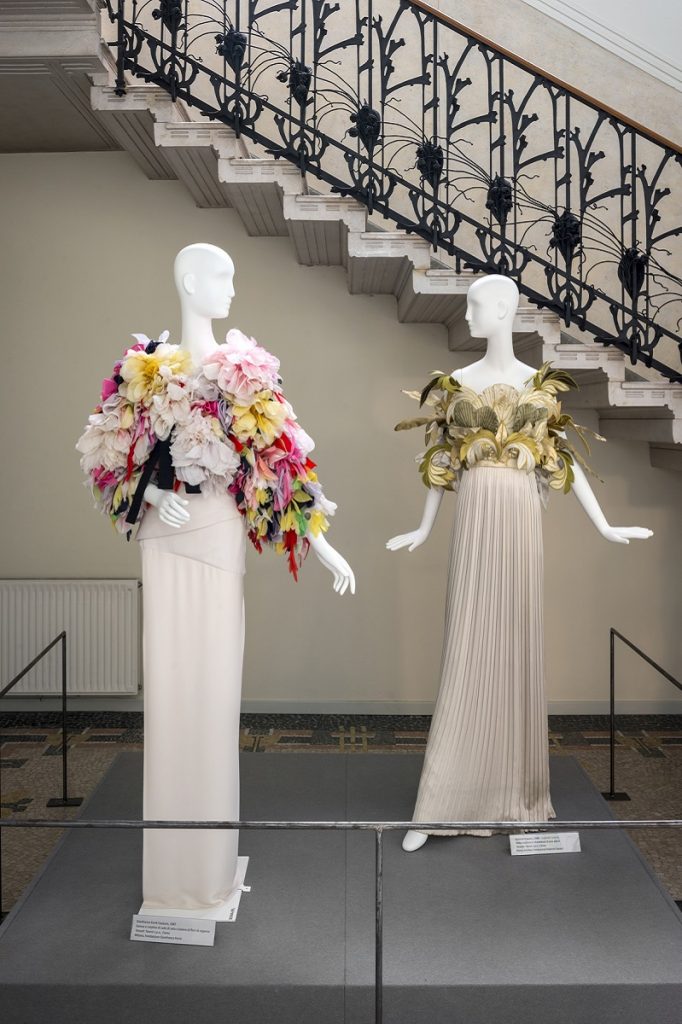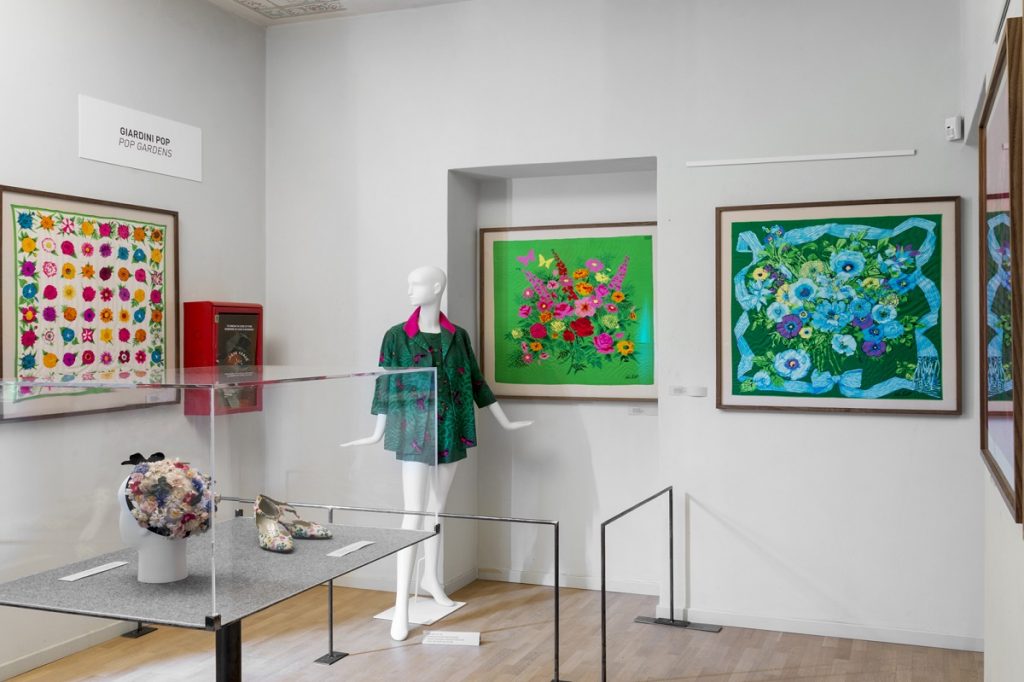Silk Gardens
Textiles and botany, silk and gardens, dresses and flowers: the exhibition The Silk Gardens of Como. Textiles, Fashion and Botany, organized by the Fondazione Antonio Ratti (FAR) and the Comune di Cernobbio, celebrates the beauty of nature and of textile creations. The exhibition, curated by Margherita Rosina and Francina Chiara – held at Villa Sucota in Como (home of the Fondazione Antonio Ratti and its Textile Museum) and Villa Bernasconi in Cernobbio from 11th July to 11th October – explores the relationship textile-botany from the eighteenth century to the present day through the various aspects of the floral decoration. The natural beauties of the Como area, the parks and the gardens overlooking the lake have always been a subject much loved by artists and creative people. They have provided suggestions and inspirations for centuries and the silk industry – established in Como in the late nineteenth century – was not exempt from this fascination.
The exhibition
The exhibition path, divided in thematic rooms, will feature floral textiles from the collections of the Fondazione Antonio Ratti, from important private collections and from historical archives of the Como silk industry. The first part of the exhibition presents: Baroque silks from Lyon where flowers and architectural elements are woven together, light taffetas decorated with sprays of roses or berries, cottons for upholstery with realistic floral triumphs of the late nineteenth century. The second part of the exhibition is dedicated to textiles from the twentieth century, which marks the development of the Como silk factories, suppliers of Italian and French haute couture and ready to wear. These sections will focus on fabrics inspired by vegetable gardens or decorated with herbs, while a whole room will include clothes and fabrics inspired by roses, loved and employed by textile decorators of every historical era. In each section, textiles will be matched with garments: Italian high fashion is represented by Biki, Capucci, Ferré and Valentino; Dior and Yves Saint Laurent stand as eminent examples of Parisian Haute Couture; and the International prêtà-porter is featured with Ken Scott and Leonard. For the first time, a selection of tables from the Fabani herbarium, lent by the Fondazione Centro Studi Nicolò Rusca in Como, will be shown to the public: an extraordinary collection of 3,000 plates of herbs and plants collected at the turn of the nineteenth and twentieth century by Giuseppe Fabani, the municipal doctor of Cernobbio. On exhibition will also be possible to see Humulus Lupulus (2015, silk-screen print on cotton, 120×150, ed.3), a work by Serena Porrati, realized on the occasion of the exhibition with the collaboration of I.S.I.S. “Paolo Carcano” of Como, that is on display at the entrance of Villa Sucota. Serena Porrati participated to the CSAV – Artists Research Laboratory of Fondazione Antonio Ratti in 2012: the exhibited work represents a further mean to underline how the botanical theme can be source of inspiration for artistic creation.
Events
The exhibition will be accompanied by an intense program of collateral events relied to nature, art and fabrics, with the collaboration of many local institutions and associations: educational laboratories on botany, with herbs-harvest and suggestions on their culinary employment (events curated by Società Ortofloricola Comense), the conference Citrus gardens and silk dreams, guided visits to some of the most beautiful historical parks of the Lario riviera (beyond Villa Sucota, also Villa del Grumello and Villa Erba), finishing with a theatrical performance at Villa Bernasconi in Cernobbio, where early twentieth-century atmospheres will be recreated (event curated by Brigata dei Novellatori) and many more. The first event of this series will be Sunrise on the lake between music and botany, on Sunday the 12th of July at 5.30 am, to welcome the sunrise with a percussions concert in Villa del Grumello’s park (on the occasion of Intorno al Festival Como Città della Musica); to follow, at 8.30 am, guided visit to Villa del Grumello and Villa Sucota parks. On this occasion the exhibition The Silk Gardens of Como displayed at Villa Sucota will be opening at 8.30 am. Furthermore, every Sunday afternoon starting from the 26th of July, free activities for kids will be organized in the park of Villa Bernasconi, Cernobbio. The venues The choice of location for the exhibition is not accidental: Villa Sucota and Villa Bernasconi, located at short distance from each other on the first basin of the western shore of Lake Como, are both examples of how textile entrepreneurs from Como have often chosen to run their activities in buildings surrounded by nature, to feed the creativity of designers and to offer customers the opportunity to enjoy the beauty of the lake. Villa Sucota, which will feature eighteenth- and nineteenth century textiles and garments from the archives of the Museum at FAR and private collections, was home to the creative offices of Ratti s.p.a. from the late 1950s to 1998; since 2010, it houses the Fondazione Antonio Ratti and its museum of antique and modern textiles, the result of the collecting passion of Antonio Ratti who, after World War II, continued and honoured the textile tradition inaugurated in Como at the end of the nineteenth century. Summer 2015 signals the opening to the public of the park of Villa Sucota which -together with Villa Olmo and Villa del Grumello – is part of the chilometro della conoscenza, a green kilometre that connects the parks of the three villas of Lake Como. In Villa Sucota, visitors will be able to walk trails and reach hidden corners, such as the belvedere or the small chapel adjoining the villa, the limonaia and the greenhouses. Villa Sucota also provides themed itineraries that will guide visitors to discover the park while describing the landscape and history of the place, as well as a path in which the public will experience installations and temporary and permanent artworks. Villa Bernasconi is such a valuable example of Art Nouveau architecture in Italy to be part of the circuit “Route européenne de l’Art Nouveau”. There, visitors will view the Como textile production since the twentieth century, side by side with creations by the leaders of Haute Couture. The villa, now owned by the Comune di Cernobbio, was built in 1905 by the architect Alfredo Campanini for the entrepreneur Davide Bernasconi, one of the pivotal founders of the silk industry in Como. The exterior and interior decoration of the villa was inspired by botanical themes related to textile design, including high reliefs depicting the cycle of the silkworm and tiles shaped as mulberry flowers.
The “rooms” of the exhibition: a thematic display Baroque gardens: sumptuous Lyonnaise silk brocades from the eighteenth century with floral motifs combined with architectural views, matched with contemporary hydrangea-themed textiles, and a hydrangea-dress by the French fashion house Leonard. Sinuous gardens: the lightness of the second half of the eighteenth century is here exemplified by brightly coloured meander silks, accompanied by men’s and women’s clothes – among them also a lavish robe à la française – decorated with flowers inspired by the East. Romantic gardens: roses, wisteria and lilacs decorate mid-nineteenth century silks that inspired the creation of dresses with flared skirts and precious book bindings intended for a refined feminine public. Gardens on the walls: typical of Victorian taste, the “greenhouse” house features lush floral decorations of great realism on its walls, here exemplified by English and French printed cottons. Roaring Twenties gardens: paint-brushed, abstract and moving flowers characterize the production of printed silks of the 1930s, the Jazz Age, featured in the exhibition through the historical archives of the silk factories of Como. Fruit and vegetables gardens: the 1950s and the explosion of printed fabrics inspired by vegetable gardens and orchards, decorations much loved especially by the French couturier Hubert de Givenchy. Herb gardens: fragrant herbs and nineteenth-century herbaria inspired the prints of textile collections for fashion and upholstery in the second half of the twentieth century, here on display next to a valuable herbarium, passionately collected by Giuseppe Fabani, municipal doctor of Cernobbio. Pop Gardens: author of brilliant vegetable designs, Ken Scott created, first for the brand Falconetto and then to his name, memorable collections that have earned him the nickname “the gardener of fashion”, collections exhibited here through clothes and scarves. Rose gardens: a beloved theme by textile creators, the rose was represented in many ways throughout the twentieth century. Next to the fabrics, in this section visitors will see garments by Capucci, Yves Saint Laurent, Valentino, Versace and Milanese tailors, all made with Como silks. Tropical gardens: jungle-design prints from the Studio Tucano archive in Como are the background of a completely embroidered mini-dress by Donatella Versace on the same subject. Enchanted gardens: the grand finale of the show, with spectacular evening gowns by Dior and Ferré Haute Couture, outstanding wearable sculptures.
Other venues
The Silk Gardens of Como is a multi-venues exhibition: beyond Villa Sucota and Villa Bernasconi, some textiles and dresses will be exhibited also at Museo didattico della Seta of Como, Villa Carlotta in Tremezzo (CO) and at MVSA – Museo Valtellinese di Storia e Arte in Sondrio. The Museo didattico della Seta lends to Villa Bernasconi a selection of its fashion collection, with crêpe de chine flowerprinted dresses that underline the value of the style of an era and of printing and sum up the work of the designer, the tracer and the photoengraver; while, on its turn, hosts a silk crêpe “Pancaldi &B” day-dress by the designer Titta Porta, printed with big flowers, coming from a private collection. At Villa Carlotta, in the princess’ bedroom, it will be possible to admire a ball dress dating back to 1850-1855, contemporary to Carlotta’s marriage. The dress is realized with a warp-printed “airy” silk taffetas and is characterized by a many-coloured flower shoots decoration, following the standards of “garden” textile design that was very common in that period. The piece is part of the antique dresses’ collection of Camilla Colombo. The MVSA will dedicate four rooms to the exhibition The Silk Gardens of Como. The first rooms will present a very evocative educational setup: big panels and a slideshow focussing on the gardens facing the Como Lake, Erbario Fabani’s tables, lavish dresses and textiles exhibited in the other venues. In the last rooms will be on show a liturgical vestment of Ponchiera’s parish, that depicts really clearly, with its flowery shoots and blooms embroidery, the theme of naturalistic embroidery of textiles, and seven precious fabric fragments landed on the occasion by FAR’s archive, with loom stylized flower decorations. All pieces displayed at MVSA are dating back to the Seventeenth century.
Images © Fondazione Antonio Ratti, photographer Giacomo Introzzi.


